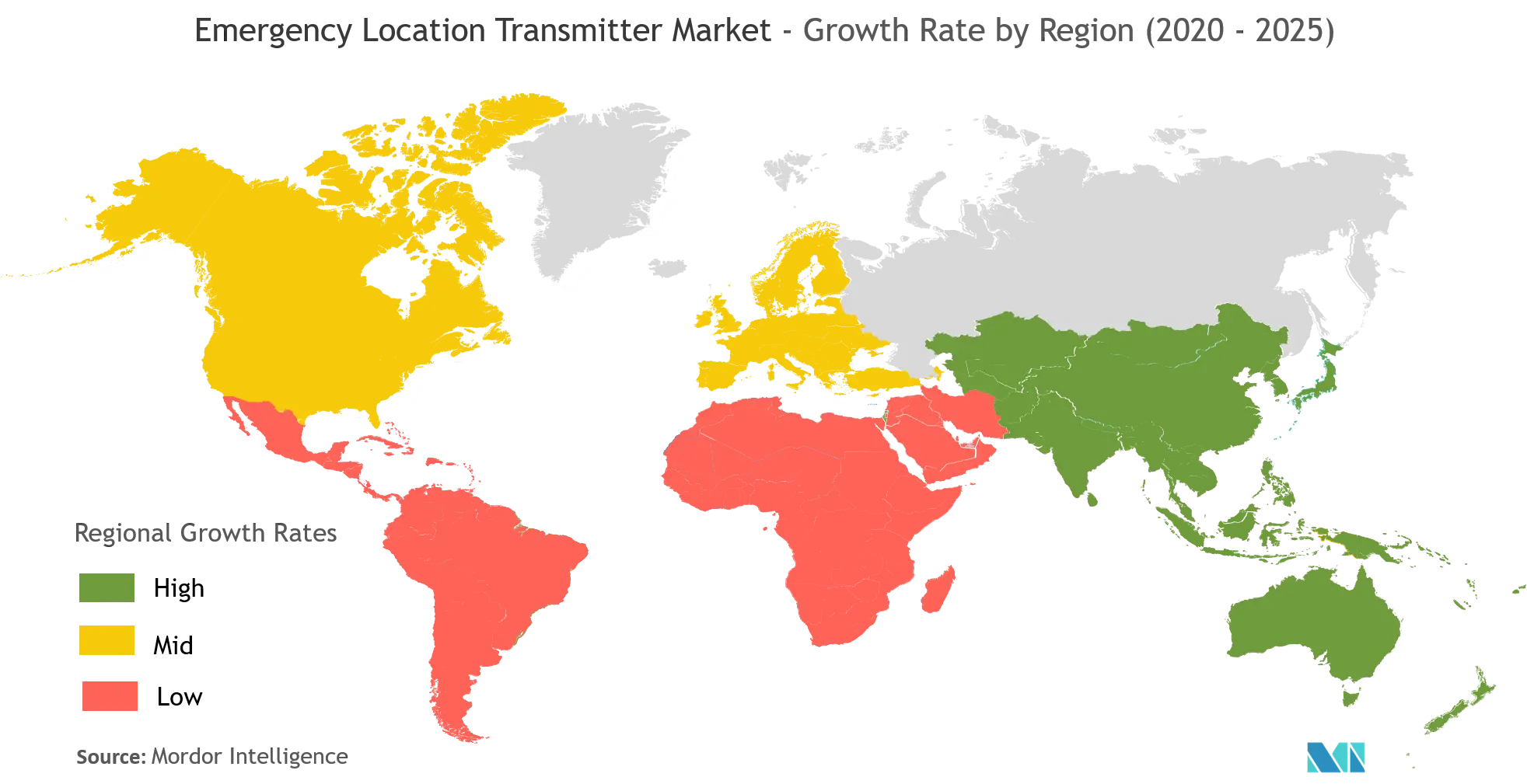Market Trends of Emergency Location Transmitter Industry
This section covers the major market trends shaping the Emergency Location Transmitter Market according to our research experts:
Aerospace Vertical to Have a Major Market Share
- The ELTs are used widely in the aerospace industry for their high reliability and efficiency. The ELT products can automatically transmit signals to the nearby rescue stations at the time of emergencies. Moreover, in 2008, the International Civil Aviation Organization (ICAO) imposed a new rule to install a minimum of one emergency location transmitter in all types of aircraft operating internationally.
- Given the estimated worldwide air traffic of about 39,000,000 flights, the accident rate is one fatal accident per almost two million flights. Reflecting on this accident rate, the Aviation Safety Network stated that the level of safety increased significantly. According to the network, if the accident rate had remained the same as 10 years ago, there may have been 34 fatal accidents last year, and at the accident rate of the year 2000, there may even have been 65 fatal accidents.
- The increasing traffic in the commercial aviation industry drives the market growth for emergency location transmitters across the world. Currently, most aviation organizations are looking for 406 MHz ELTs for higher reliability at the time of emergencies. For instance, AOPA supports the installation of advanced(406 MHz ETLs) voluntarily. They also support the awareness of pilots and aircraft owners about the limit of 121.5/243 MHz ELTs and the benefits of 406 MHz units.
- Major vendors in this market are also focusing on 406MHz ELTs due to the efficiency of the 406 MHz frequency, searchers can respond more quickly in the event of an alert. Another significant benefit of the 406 MHz ELT is that it can transmit coded digital information about the aircraft and its owner. For instance, in 2019, Astonics Corporation launched an upgraded version of the emergency locator transmitter (SRB 406G- S type ELT) for aircraft life rafts. It incorporated with GPS locator technology, which can provide satellite-based position assistance during search and rescue operations.
- In 2019, Orolia launched Kannad Ultima-S ELT for commercial aircraft. This ELTs can be installed at the commercial aircraft cabin and notify the crew about the status of a search and rescue operation by its Return Link Service. Moreover, this product is also capable of transmitting 406MHz at the time of emergencies. Furthermore, the company has also provided Survival ELTs to India’s SpiceJet industry. Its survival ELTs can send the signal of 406, 243, and 121.5 MHz and can provide distress signals during emergencies.
- Moreover, major vendors in this industry are continuously improving their technologies to adapt to the recent changes in technologies around the world. For instance, in 2020, Honeywell plans to develop a fully-retrofittable solution with the help of emergency locator transmitter hardware and an updated version of the EGPWS MK V-A. This solution can automatically trigger signals at the time of distress situations.

North America to Hold the Largest Market Share
- North America is expected to dominate the market studied during the forecast period, owing to the prominence of the US aviation network among all the regions. The various aspects attributed to the growth in aviation in this region were the undeveloped public transport systems, difficult terrains, high average household income, and low crude oil prices.
- North America has adapted to several aviation requirements in the past few years, which is evident from the emergence of general aviation in this region. General aviation is all civilian flying except scheduled passenger airline service.
- The United States alone has around 780 towered locations to carry out aviation-based operations. Additionally, 90% of 220,000 aircraft registered in this region are general aviation aircraft, and more than 80% of the 609,000 pilots certificated in the United States fly general aviation aircraft. This is the fastest-growing segment, which contributed to the demand for emergency location transmitters. According to the report published in 2019, by FAA, 2,324 aircraft were added in 2017 alone, and there were about 213,050 functional aircraft in this region.
- This region sees the highest number of flights, with more than 7.5 million trips annually. Due to which, FAA has mandated the requirement of ELT on the aircraft registered in the United States or using their airspace. The regulation first came into effect in 1976 and was updated in 2009. Due to the growing disposable incomes and broader application of general aviation into transport, agriculture, survey, and recreational activities, this segment are expected to witness an increased demand for ELTs.
- ELTs have played a significant role in rescue missions lately, as this region recorded 330 accidents related to general aviation in 2017 alone. Since these flights do not follow the asset route, it becomes difficult to trace them without ELTs.
- The United States is also the largest exporter for defense aircraft and exports them to countries like Canada, Japan, Australia, Pakistan, and South Korea. In August 2019, the United States started shipment of Apache helicopters to India, and Chinook helicopter will also be delivered to India.
- The recreation boat is the primary consumer when it comes to the number of ELTs used in maritime activities in this region. The National Marine Manufacturers Association of the United States estimates a surge in demand for powerboats in the region. The agency further shared that about 280,000 units were sold in 2018 in the United States, which was the highest in the past ten years.


